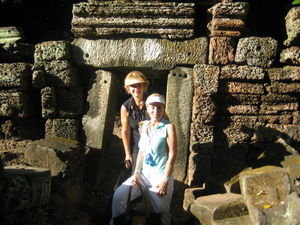Advertisement
Published: November 21st 2007

 Angkor Wat
Angkor Wat
We still can't beleive we were hereNov. 14 to Nov 17
NAMASTE from SIEM REAP, Cambodia
We arrived in Siem Reap to a beautiful pagoda styled terminal.
Greeted by Cambodian girls in traditional dress, they draped colourful scarves around our necks. These scarves ( also called “Krama”---a.k.a. Shmatas) are more than just pretty decoration. The history of this scarf is important to Cambodia. The Krama, our guide informed us, is multi-purpose. It may be used to wipe one’s brow of sweat and dirt, to offer protection from the sun, shield one’s mouth and nose against pollution, smoke and smells, and finally, to offer a degree of modesty in the fields (that often serve as toilets)
(We two efficient travellers have added to this multi-usage shmatas by also using them as hair ties, belts and shawls.) These scarves traditionally were checkered to distinguish the Khmeers (Cambodians) from their neighbours. In the interest of native culture, and the Cambodian economy, Lindsay and M.E. have invested many many Riels (equivalent to One U.S. “Dollah ” each) in Cambodia’s scarf industry.
Cambodia is a country populated by 14 million. It is also one of the poorest countries on the earth. Torn by centuries of war and dictators, almost one
half of the nation lives on less than $1 dollar U.S. a day. Fifty percent of its large population of children under the age of five are malnourished.
In Siem Reap (it’s name meaning “The Defeat of Siam”), there are 100,000 people. When all the outlying districts are included, including Angkor area, the population is actually 800,000.
The highlight of our visit here was to one of existing Seven Great (man-made) Wonders of the World, ------Angkor Wat. This complex, meaning “City Temple” was built in the 12th Century. Surrounded by a moat, this magnificent Buddhist structure is filled with intricate sand stone sculptures, shrines, tunnels and hallways. As we explored the complicated labyrinths, we approached an area which afforded us a magnificent sunset view. The fading light turned the dark stone surfaces of the walls to a shimmering golden wonder ---a breathtaking sight. Since being declared a World Heritage sight by U.NE.S.C.O, millions of dollars from many other country sponsors have been poured into the much-needed restoration of the temple and surrounding area.
We visited Ta Prohm, the Jungle Temple that was like discovering a lost city. Deep in a dense tropical forest, the first glimpse was
quite extraordinary, almost spiritual. The sight of huge vines and massive banyan trees wrapping their overgrown limbs and roots like tentacles around the temple stones was like nothing we’d ever seen. Unfortunately the pictures do not do justice to the phenomenal beauty of this fairy story-like spot.
The greenness and lushness of Cambodia is not dissimilar to parts of Florida (M.E. keeps remarking that if looks like Palm Beach before all the condos) .
We spent 3 remarkable and very full days in the Siem Reap area seeing so many special sights----Angkor Thom, the Elephant Terrace, Bayon, and the Terrace of the Leper King.
One afternoon we visited Tonle Sap, the Great Lake, to see the unique Floating Village, where houses on stilts are home to over 700 families (about 5,000 people ) who live, eat, bathe and exist on the water that is polluted with raw sewage. There are approximately 128 of these villages bringing the population of this "WaterWorld" (-just like the film) with Kevin Costner) to almost half a million people
Our hearts were torn by the poverty of these communities, whose peoples have lived in this fashion for over 1000 years.
After returning to our
hotel for the requisite (and very cheap) reflexology foot massages, we couldn't help but reflect on our own very good fortune and blessings.
Perhaps the most memorable experience of our stay in Cambodia occurred on the last day when we finally had a rest from group touring. We decided to visit the Cambodian Land Mine Museum. This small and makeshift outdoor display of Russian and Chinese fighter planes, tanks and artillery receives no government funding or attention. Our excellent guide who was orphaned in the 70’s by the atrocities committed by the Pol Pot regime, served as witness to this tragic genocide. This short visit gave us lots to reflect upon.
On the same morning we stopped at the Cambodian Artisan School for war orphans where talented students learn traditional crafts of stone carving, painting and textile making.
So sadly now, we leave Cambodia, a beautiful country filled with gentle, gracious people who always greet you with hands grasped together, a bow, and say “namaste” which is Hindi for hello/welcome/peace. (an ego-less greeting)
So now we say Lee-a-hai-ee (good bye) from Siem Reap.
We’re off to Agra, India and the Taj Mahal. Also looking forward to
a long plane ride on our private jet, as this is the only time we can really relax.
Love and hugs to our families and friends,
Lindsay and MaryEllen
xxxxooooo
Thanks to Jackie, Andrea and Phil B. for all the research info on Vietnam and on Cambodia
and thanks to everyone for writing to us.....we love hearing from you. Thinking of you all and missing you.
Advertisement
Tot: 0.073s; Tpl: 0.015s; cc: 7; qc: 46; dbt: 0.0437s; 1; m:domysql w:travelblog (10.17.0.13); sld: 2;
; mem: 1.1mb

























Pam
non-member comment
Wow!
I'm glad you 2 are having so much fun. Enjoy!